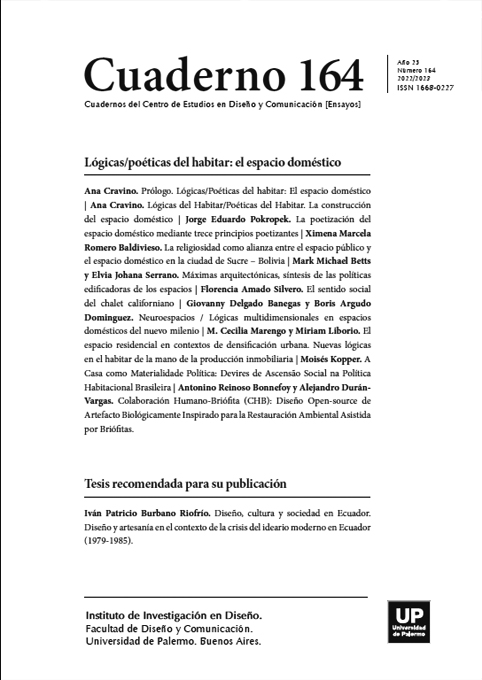Colaboración Humano-Briófita (CHB): Diseño Open-source de Artefacto Biológicamente Inspirado para la Restauración Ambiental Asistida
Resumen
Habitar ecosistemas urbanos genera cambios en las rutinas de movilidad que nos lleva a vivir más del 80% de nuestro tiempo en espacios cerrados. Esta forma de habitar presenta externalidades negativas asociadas a la contaminación ambiental producida por la reducción de intercambio interior-exterior de aire, aumentando la concentración de CO2 y otros compuestos volátiles orgánicos.
Citas
Benner, A. (2019) En Beneficial characteristics of moss. AEC1206 Live Moss Wellness Walls: Soothing the Senses and Revitalizing Indoor Air (pg. 33). AEC Daily Corporation.
Brasche, S., Bullinger, M., Gebhardt, H., Herzog, V., Hornung, P., Kruppa, B., Meyer, E., Morfeld, M., Schwab, R. V., Mackensen, S., Winkens, A. and Bischof, W. (1999). ‘Factors Determining Different Symptom Patterns of Sick Building Syndrome – Results From a Multivariate Analysis’, in Proceedings of Indoor Air ‘99. The 8th International Conference on Indoor Air Quality and Climate, Edinburgh, Scotland, August, 1999, pp. 402–407.
Brown, D. C., & Blessing, L. (2005). The relationship between function and affordance. In International Design Engineering Technical Conferences and Computers and Information in Engineering Conference (Vol. 4742, pp. 155-160).
Brown, S. K., Sim, M. R., Abramson, M. J., & Gray, C. N. (1994). Concentrations of volatile organic compounds in indoor air–a review. Indoor air, 4(2), 123-134.
Campusano, R. (2012). Síndrome del edificio enfermo. Revista SustentaBit. Recuperado de http://colegioarquitectos.com/noticias/wp-content/uploads/2012/02/Rev-SustentaBit.pdf
Earth System Research Laboratories Global Monitoring Laboratory (2020) Global Monthly Mean CO2. ESRL NOAA. Recuperado de https://www.esrl.noaa.gov/gmd/ccgg/trends/global.html
Garbisu, C., Amézaga, I., & Alkorta, I. (2002). Biorremediación y ecología. Revista Ecosistemas, 11(3).
Glime, J. M. (2007). Economic and ethnic uses of bryophytes. Flora of North America, 27, 14-41.
Gong, G. Y., Kang, J. S., Jeong, K. J., Jeong, J. H., & Yun, J. G. (2019). Effect of Several Native Moss Plants on Particulate Matter, Volatile Organic Compounds and Air Composition.
Gutiérrez F. & Albanchez, I. (2010) Botánica. Ed. Firmas Press. Montevideo, Uruguay. 172 p.
Han, K. T. (2003). A reliable and valid self-rating measure of the restorative. Landscape and Urban Planning, 64(4), 209-232.
Han, K. T. (2009). Influence of limitedly visible leafy indoor plants on the psychology, behavior, and health of students at a junior high school in Taiwan. Environment and Behavior, 41(5), 658-692.
Ii, H., Taguchi, K., & Yamashita, M. (2016). Natural ventilation effect on CO2 concentration in the classroom, Wakayama University, Japan. International Journal, 10(21), 1936-1942.
Kaplan, R. & Kaplan, S. (1989). The Experience of Nature: A Psychological Perspective. CUP Archive.
Kaplan, R., Kaplan, S. & Ryan, R. (1998). With People in Mind: Design and Management of Everyday Nature. Washington DC: Island Press.
Lenau, T. A., Metze, A. L., & Hesselberg, T. (2018). Paradigms for biologically inspired design. In Bioinspiration, Biomimetics, and Bioreplication VIII (Vol. 10593, p. 1059302). International Society for Optics and Photonic
Llewellyn, D., & Dixon, M. (2011). 4.26 Can plants really improve indoor air quality. Comprehensive Biotechnology (Second Edition), Academic Press, Burlington, 331-338.
National Aeronautics and Space Administration. (1974). Proceedings of the Skylab Life Sciences Symposium, 27-29 agosto, 161-168. NASA TM-X-58154. Houston, TX: Johnson Space Center.
Norman, D. A. (1998). La psicología de los objetos cotidianos (Vol. 6). Editorial Nerea.
Omora, F. (2004). Explorando la Micro-Biodiversidad del Cabo de Hornos Oxford Language. (s.f.). Lexico. Recuperado de https://www.lexico.com/es/definicion/artefacto
Persily, A. K., & Gorfain, J. (2008). Analysis of ventilation data from the US. Environmental Protection Agency Building Assessment Survey and Evaluation (BASE) Study, NISTIR7145-Revised. US National Institute of Standards and Technology.
Rivero, T., & Schulmeyer, M. K. (2018). El impacto del medio ambiente en estudiantes universitarios. Percepción del efecto restaurador de imágenes naturales y urbanas. Ajayu. Órgano de Difusión Científica del Departamento de Psicología UCBSP, 16(1), 150-171.
Satish, U., Mendell, M. J., Shekhar, K., Hotchi, T., Sullivan, D., Streufert, S., & Fisk, W. J. (2012). Is CO2 an indoor pollutant? Direct effects of low-to-moderate CO2 concentrations on human decision-making performance. Environmental health perspectives, 120(12), 1671-1677.
Schires, M. (2019) La importancia de diseñar contemplando una buena calidad de aire interior. Plataforma Arquitectura. (Trad. Castro, Fernanda) Plataforma Arquitectura Recuperado de:https://www.plataformaarquitectura.cl/cl/916475/la-importancia-dedisenar-contemplando-una-buena-calidad-de-aire-interior
Soria, A. & Ron, E. (1995). Los briófitos y el medio urbano. Agricultura: Revista agropecuaria y ganadera, (751), 96-101.
Taylor, A. F., Kuo, F. E. & Sullivan, W. C. (2001). The surprising connection to green play settings. Environment and behavior, 33(1), 54-77.
Thomsen, Mads S., et al. (2010). “Habitat Cascades: The Conceptual Context and Global Relevance of Facilitation Cascades via Habitat Formation and Modification.” Integrative and Comparative Biology, vol. 50, no. 2, Aug. 2010, pp. 158–75. DOI.org (Crossref), https://doi.org/10.1093/icb/icq042.
UNFPA. (2007). State of world population 2007: unleashing the potential of urban growth. In State of world population 2007: unleashing the potential of urban growth. UNFPA.
Vargas, F., & Gallego, I. (2005). Calidad ambiental interior: bienestar, confort y salud. Revista española de salud pública, 79, 243-251.
Wolverton, B. C., Johnson, A., & Bounds, K. (1989). Interior landscape plants for indoor air pollution abatement.
World Health Organization Regional Office for Europe. (2008). Sick building syndrome. ONU. Recuperado de www.wondermakers.com/Portals/0/docs/Sick%20building%20syndrome%20by%20WHO.pdf
Los autores/as que publiquen en esta revista ceden los derechos de autor y de publicación a "Cuadernos del Centro de Estudios de Diseño y Comunicación", Aceptando el registro de su trabajo bajo una licencia de atribución de Creative Commons, que permite a terceros utilizar lo publicado siempre que de el crédito pertinente a los autores y a esta revista.


